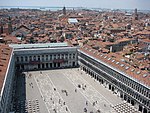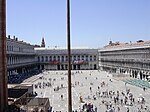The Marciana Library or Library of Saint Mark (Italian: Biblioteca Marciana, but in historical documents commonly referred to as Libreria pubblica di san Marco) is a public library in Venice, Italy. It is one of the earliest surviving public libraries and repositories for manuscripts in Italy and holds one of the world's most significant collections of classical texts. It is named after St Mark, the patron saint of the city.
The library was founded in 1468 when the humanist scholar Cardinal Bessarion, bishop of Tusculum and titular Latin patriarch of Constantinople, donated his collection of Greek and Latin manuscripts to the Republic of Venice, with the stipulation that a library of public utility be established. The collection was the result of Bessarion's persistent efforts to locate rare manuscripts throughout Greece and Italy and then acquire or copy them as a means of preserving the writings of the classical Greek authors and the literature of Byzantium after the fall of Constantinople in 1453. His choice of Venice was primarily due to the city's large community of Greek refugees and its historical ties to the Byzantine Empire. The Venetian government was slow, however, to honour its commitment to suitably house the manuscripts with decades of discussion and indecision, owing to a series of military conflicts in the late-fifteenth and early-sixteenth centuries and the resulting climate of political uncertainty. The library was ultimately built during the period of recovery as part of a vast programme of urban renewal aimed at glorifying the republic through architecture and affirming its international prestige as a centre of wisdom and learning.
The original library building is located in Saint Mark's Square, Venice's former governmental centre, with its long façade facing the Doge's Palace. Constructed between 1537 and 1588, it is considered the masterpiece of the architect Jacopo Sansovino and a key work in Venetian Renaissance architecture. The Renaissance architect Andrea Palladio described it as "perhaps the richest and most ornate building that there has been since ancient times up until now" ("il più ricco ed ornato edificio che forse sia stato da gli Antichi in qua"). The art historian Jacob Burckhardt regarded it as "the most magnificent secular Italian building" ("das prächtigste profane Gebäude Italiens"), and Frederick Hartt called it "one of the most satisfying structures in Italian architectural history". Also significant for its art, the library holds many works by the great painters of sixteenth-century Venice, making it a comprehensive monument to Venetian Mannerism.Today, the building is customarily referred to as the 'Libreria sansoviniana' and is largely a museum. Since 1904, the library offices, the reading rooms, and most of the collection have been housed in the adjoining Zecca, the former mint of the Republic of Venice. The library is now formally known as the Biblioteca nazionale Marciana. It is the only official institution established by the Venetian Republican government that survives and continues to function.











